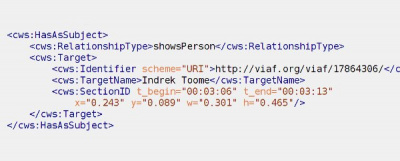Approaching the subject of a film work
From filmstandards.org
From the TC 372 Workshop Compendium
A worked example
Documentary films are typically searched for by subject. While content description and keyword indexing are mainstay procedures in film cataloguing, today's networked environment allows for almost anything to be related to a cinematographic work in the role of subject.
|
<mediaplayer image='http://filmstandards.org/media/hobuse_aasta_frame.png'>http://filmstandards.org/media/hobuse_aasta_clip1_ori.flv</mediaplayer>
|
This is a documentary about events in Estonia before the country gained independence from the Soviet Union in early 1991. The clip contains images from the parliamentary assembly of 26 January, 1990, in which an amendment of the constitution was attempted. The content of this clip clearly focuses on people, in this case on those that represented the leading political class in Estonia until 1990. |
